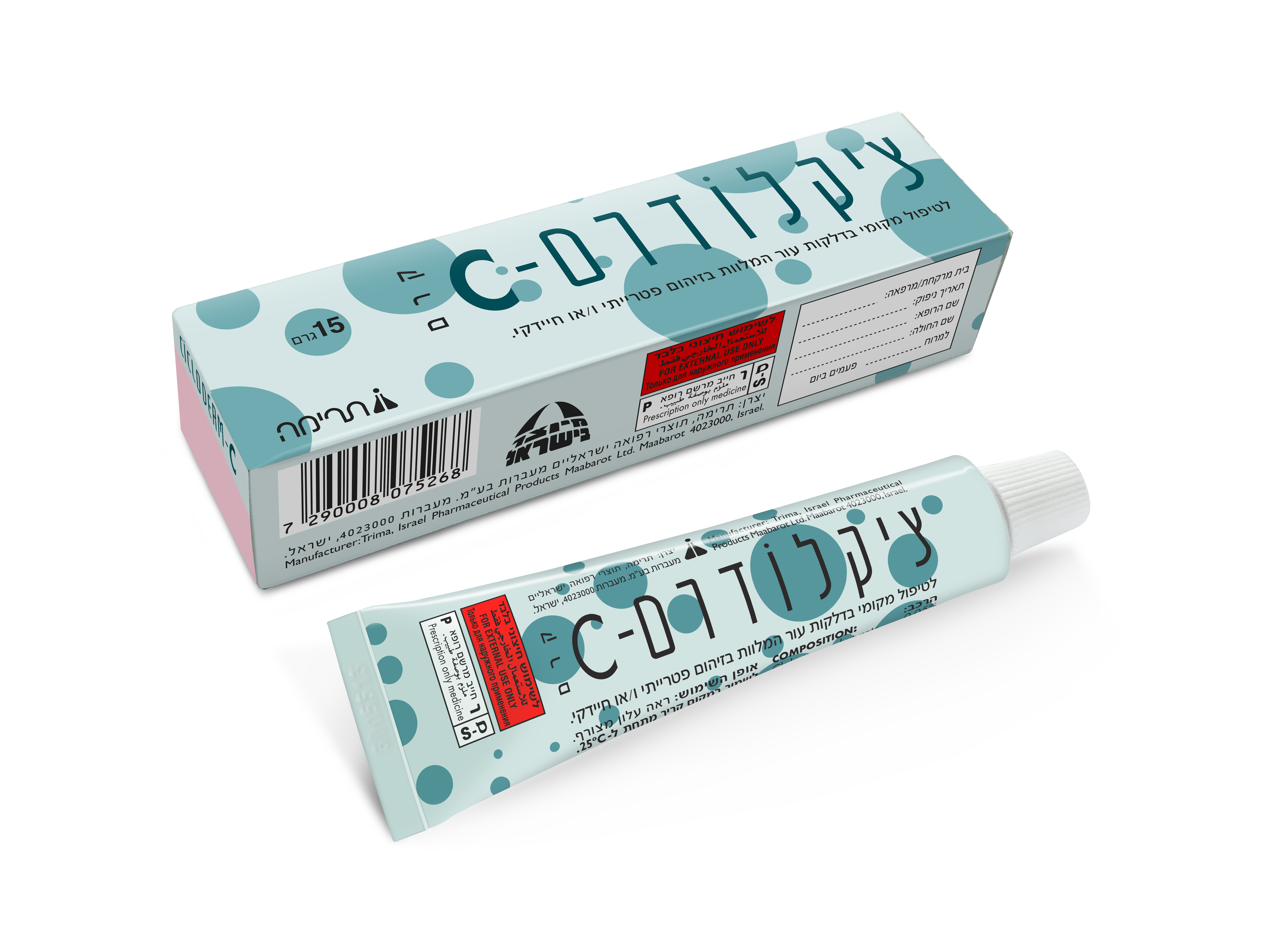Quest for the right Drug

ציקלודרם C CICLODERM C (CICLOPIROX OLAMINE, CLOBETASONE BUTYRATE, GENTAMICIN (AS SULFATE))
תרופה במרשם
תרופה בסל
נרקוטיקה
ציטוטוקסיקה
צורת מתן:
עורי : DERMAL
צורת מינון:
קרם : CREAM
עלון לרופא
מינוניםPosology התוויות
Indications תופעות לוואי
Adverse reactions התוויות נגד
Contraindications אינטראקציות
Interactions מינון יתר
Overdose הריון/הנקה
Pregnancy & Lactation אוכלוסיות מיוחדות
Special populations תכונות פרמקולוגיות
Pharmacological properties מידע רוקחי
Pharmaceutical particulars אזהרת שימוש
Special Warning עלון לרופא
Physicians Leaflet
Pharmacological properties : תכונות פרמקולוגיות
Pharmacodynamic Properties
5.1 Pharmacodynamic properties ATC code D07AB Corticosteroids, moderately potent (group II) D07AB30 Combinations of corticosteroids D01AE Other antifungals for topical use D01AE Combinations D06AX Other antibiotics for topical use D06AX07 Gentamicin Mechanism of action Topical corticosteroids act as anti-inflammatory agents via multiple mechanisms to inhibit late phase allergic reactions including decreasing the density of mast cells, decreasing chemotaxis and activation of eosinophils, decreasing cytokine production by lymphocytes, monocytes, mast cells and eosinophils, and inhibiting the metabolism of arachidonic acid. Ciclopirox is a hydroxypyridone antifungal agent that acts by chelation of polyvalent cations (Fe or Al), resulting in the inhibition of the metal-dependent enzymes that are responsible for the degradation of peroxides within the fungal cell. Gentamicin sulfate is a wide spectrum antibiotic that provides highly effective topical treatment in primary and secondary bacterial infections of the skin. Bacteria susceptible to the action of gentamicin sulfate include sensitive strains of Streptococci (group A beta-hemolytic, alphahemolytic), Staphylococcus aureus (coagulase positive, coagulase negative, and some penicillinaseproducing strains), and the gram-negative bacteria, Pseudomonas aeruginosa, Aerobacter aerogenes, Escherichia coli, Proteus vulgaris and Klebsiella pneumoniae. Pharmacodynamic effects Topical corticosteroids, have anti-inflammatory, antipruritic and vasoconstrictive properties. Clobetasone butyrate has little effect on hypothalamo-pituitary-adrenal function. This was so even when clobetasone butyrate cream was applied to adults in large amounts under whole body occlusion. Clobetasone butyrate is less potent than other available corticosteroid preparations and has been shown not to suppress the hypothalamo-pituitary-adrenal axis in patients treated for psoriasis or eczema. Pharmacological studies in man and animals have shown that clobetasone butyrate has a relatively high level of topical activity accompanied by a low level of systemic activity.
Pharmacokinetic Properties
5.2 Pharmacokinetic properties Absorption and Distribution Topical corticosteroids can be systemically absorbed from intact healthy skin. The extent of percutaneous absorption of topical corticosteroids is determined by many factors, including the vehicle and the integrity of the epidermal barrier. Occlusion, inflammation and/or other disease processes in the skin may also increase percutaneous absorption. A single application of 30g clobetasone butyrate 0.05% ointment to eight patients resulted in a measurable rise in plasma clobetasone butyrate levels during the first three hours but then the levels gradually decreased. The maximum plasma level reached in the first three hours was 0.6ng/ml. This rise in levels was followed by a more gradual decline with plasma levels of clobetasone butyrate falling below 0.1ng/ml (the lower limit of the assay) after 72 hours. The normal diurnal variation in plasma cortisol levels was not affected by the application of clobetasone butyrate ointment. The use of pharmacodynamic endpoints for assessing the systemic exposure of topical corticosteroids is necessary due to the fact that circulating levels are well below the level of detection. Metabolism Once absorbed through the skin, topical corticosteroids are handled through pharmacokinetic pathways similar to systemically administered corticosteroids. They are metabolised, primarily in the liver. Elimination Topical corticosteroids are excreted by the kidneys. In addition, some corticosteroids and their metabolites are also excreted in the bile. Pharmacokinetic studies in men with tagged ciclopirox solution in polyethylene glycol 400 showed an average of 1.3% absorption of the dose when it was applied topically to 750 cm on the back followed by occlusion for 6 hours. The biological half-life was 1.7 hours and excretion occurred via the kidney. Two days after application only 0.01% of the dose applied could be found in the urine. Fecal excretion was negligible. Penetration studies in human cadaverous skin from the back, with LOPROX® ciclopirox cream with tagged ciclopirox showed the presence of 0.8 to 1.6% of the dose in the stratum corneum 1.5 to 6 hours after application. The levels in the dermis were still 10 to 15 times above the minimum inhibitory concentrations. Autoradiographic studies with human cadaverous skin showed that ciclopirox penetrates into the hair and through the epidermis and hair follicles into the sebaceous glands and dermis, while a portion of the drug remains in the stratum corneum. Draize Human Sensitization Assay, 21-Day Cumulative Irritancy study, Phototoxicity study, and PhotoDraize study conducted in a total of 142 healthy male subjects showed no contact sensitization of the delayed hypersensitivity type, no irritation, no phototoxicity, and no photo- contact sensitization due to ciclopirox cream.

שימוש לפי פנקס קופ''ח כללית 1994
לא צוין
תאריך הכללה מקורי בסל
לא צוין
הגבלות
לא צוין
רישום
068 06 27821 00
מחיר
0 ₪
מידע נוסף
